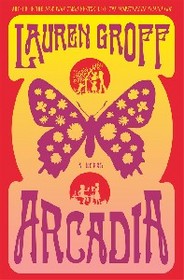Helpful Score: 1
When I first started reading Arcadia, I felt like the eponymous commune had to be based on a real place. Many other people before me had already deduced that it's based quite heavily on The Farm, an "intentional community" (that's apparently hippie-speak for commune) in Tennessee, that started in 1971 and is still in operation today. I'd actually heard of The Farm before, because Ina May Gaskin (who is the real-life counterpart of Astrid) is super-famous amongst natural, home-birth types. I found the real place almost as fascinating as Groff's fictional setting, especially as recalled in Life on the Bus and Farm: an Informal Recollection by John Coate.
I absolutely love the first half of the book -- starting with the heyday of Arcadia, when the protagonist Bit is about 5 years old, and then the crazy, excessive implosion of the community when he is about 14. The entire book is beautifully written, but I love the manic magic of commune life. Groff creates a cast of eccentric, entertaining characters who are entirely believable. Although the novel is written in third-person, the reader sees the world through Bit's eyes, with his innocence.
The second half takes place in the "real world" when Bit is an adult, following through on the way his early years have affected him and others from Arcadia. My favorite parts of the second half are the diverse paths that the commune members took in the outside world, especially the kids. But overall, I felt like the second half moved in a slow decline and I didn't love the ending.
If I were to rate the two halves, I'd give the first half 5 stars and the second half 3 stars, averaging out to 4.
I absolutely love the first half of the book -- starting with the heyday of Arcadia, when the protagonist Bit is about 5 years old, and then the crazy, excessive implosion of the community when he is about 14. The entire book is beautifully written, but I love the manic magic of commune life. Groff creates a cast of eccentric, entertaining characters who are entirely believable. Although the novel is written in third-person, the reader sees the world through Bit's eyes, with his innocence.
The second half takes place in the "real world" when Bit is an adult, following through on the way his early years have affected him and others from Arcadia. My favorite parts of the second half are the diverse paths that the commune members took in the outside world, especially the kids. But overall, I felt like the second half moved in a slow decline and I didn't love the ending.
If I were to rate the two halves, I'd give the first half 5 stars and the second half 3 stars, averaging out to 4.
Helpful Score: 1
This was interesting and so endearing. I postponed finishing it because I didn't want to leave Bit.




